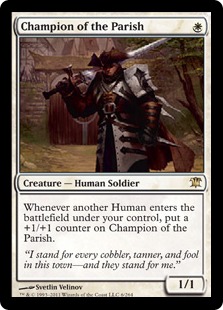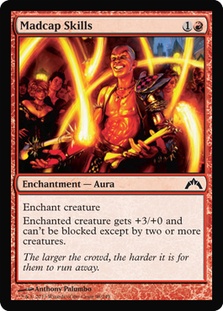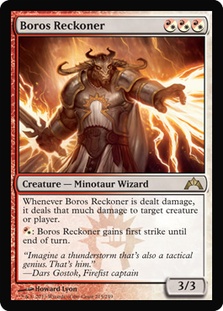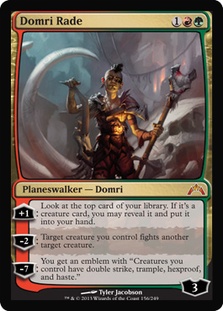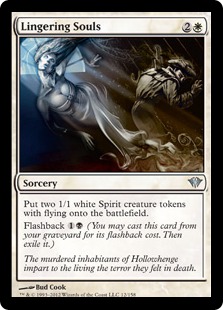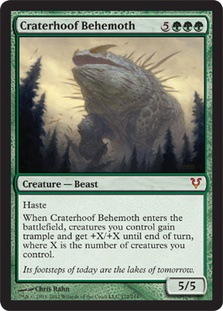There’s something a little off about Standard. There’s something that feels not quite right that’s a little different from what we’re used to. What sets this Standard format apart from the ones we’ve grown used to over the past few years is that there’s no real dominant deck.
Since I started writing for StarCityGames.com back in 2010, I always remember my Standard articles being framed like "what it takes to beat Valakut" or "tips for playing against U/B Faeries." In my own tournament preparation, I would make it my first goal to beat the dominant deck, and everything else that I would normally look for in a deck had to be an afterthought. Today, there is no such deck and no such clear direction for deckbuilders.
Even in the early days of this format, we had B/R Zombies and Junk Reanimator, which at their respective times stood clear as the decks to beat. But today, the giant pool of excellent cards in Standard simply poses too many different challenges for a single deck to rise to the top.
While it can be overwhelming to come into a tournament without much idea of what you’re likely to face or what you’ll need to do to win, such a diverse format also means rich and interesting possibilities for those willing to explore. Today I’ll offer an overview of what Standard looks like currently and what challenges you’ll have to face if you want to truly master it.
Naya Blitz
Creatures (36)
- 4 Champion of the Parish
- 4 Mayor of Avabruck
- 4 Lightning Mauler
- 4 Flinthoof Boar
- 4 Boros Elite
- 4 Burning-Tree Emissary
- 4 Experiment One
- 4 Frontline Medic
- 4 Firefist Striker
Lands (21)
Spells (3)

With so many incredible aggro cards in Standard, players have found a seemingly limitless number of ways to fling huge amounts of damage very quickly. Even aggressive decks within the same combination of colors can be built in wildly different ways.
All that said, the Naya Blitz deck remains the single fastest deck in Standard. Speaking from personal experience, I once had the dubious honor of being knocked out of a Grand Prix Top 8 by being attacked for fourteen on turn 3! I lost that game without casting a spell despite playing Jund, a deck which I consider quite good against opposing creature decks.
Naya Blitz players go a bit out of their way in terms of card choices and mana base in order to make use of Champion of the Parish. Champion in Naya Blitz is probably better than any card in Standard is in any other deck. If you promised me that I could have a Champion in every opening hand, I would immediately drop everything and play Naya Blitz.
The problem, of course, is that such a focused aggressive deck has very few ways to come back from behind. You won’t have time to draw out of an awkward opening hand and will have to mulligan quite a lot. In many cases, you won’t have much luxury to play around a board sweeper, and you will need to put yourself in a position where you’re likely to lose if the opponent has Supreme Verdict or Bonfire of the Damned but will almost certainly win if they do not.
As long as you’re willing to accept these risks, though, Naya Blitz is an excellent deck and gets my seal of approval. In a diverse format, it’s a great feeling to be playing the single fastest deck because you don’t need to worry much about what unusual cards your opponent might be playing. Your goal is clear, and you’ll often just win the game before anything bad can happen to you!
Gene Richtsmeier list is even more single-minded than usual, forgoing Searing Spear for Madcap Skills. This is not a change that I particularly like. One appeal of Naya Blitz is that you can empty your hand so quickly that you often force your opponent to have a sweeper effect—simple spot removal is typically not good enough. However, Madcap Skills makes you substantially more vulnerable to spot removal, perhaps allowing a two-for-one trade to put a Jund Midrange or U/W/R player back in the game, whereas simply dropping an additional creature would put on too much pressure.
Admittedly, Madcap Skills puts out a lot of damage very quickly (you could think of it as a three power creature with haste). However, the cannot-be-blocked ability is only somewhat helpful for a deck that needs to be attacking with many creatures each turn anyway. If your opponent cannot block one of your creatures, they’ll just block a different one.
Mono-Red Aggro
Creatures (32)
- 4 Stromkirk Noble
- 4 Hellrider
- 4 Flinthoof Boar
- 4 Rakdos Cackler
- 4 Burning-Tree Emissary
- 4 Ghor-Clan Rampager
- 3 Firefist Striker
- 4 Boros Reckoner
- 1 Pyrewild Shaman
Lands (19)
Spells (9)
Sideboard

Mono-Red Aggro, or the popular variant that splashes green, is a hyperaggressive deck that sacrifices the tribal synergies of Naya Blitz for more reach in the form of burn and Hellrider.
Hellrider must get the award for the scariest card in Standard; the mere threat of it changes the entire dynamic of a matchup. While I’ve seen faster, lower-curve Mono-Red decks, I very much like Marvin Gonzalez’s build because Hellrider represents both a great follow-up to a board sweeper and a way to unleash tons of damage against an opponent trying to mount a defense with blockers or life gain.
Also not to be discounted is the presence of Boros Reckoner, which is one of the most powerful cards in any red aggro mirror match.
There’s not much that I can say about Mono-Red that isn’t apparent from a quick scan of the decklist, but suffice it to say that it is an effective strategy that will continue to be a major player in Standard.
Bant Hexproof
Creatures (20)
Lands (23)
Spells (17)
Sideboard

Red aggro represents the fastest strategy in Standard. However, Bant Hexproof, while very different, is another strategy devoted purely to attacking the opponent to death.
What it lacks in pure speed, it makes up for in the resilience of its threats and the ability to race with Unflinching Courage or Gift of Orzhova.
Where Naya Blitz has Champion of the Parish, Bant Hexproof has Geist of Saint Traft as a card that makes the deck dramatically better when it appears in the opening hand. However, with the right draw, Bant Hexproof can make any creature a deadly threat and can even play Voice of Resurgence and Loxodon Smiter, which are simply among the best plays possible at their spot on the mana curve.
There are two possible builds of a Hexproof strategy, Bant and U/W/R, each with different advantages. For a brief discussion of the two, check out Mike Flores‘ article from last week.
Domri Naya
Creatures (27)
- 4 Avacyn's Pilgrim
- 3 Restoration Angel
- 4 Thundermaw Hellkite
- 3 Flinthoof Boar
- 3 Loxodon Smiter
- 2 Experiment One
- 4 Boros Reckoner
- 4 Voice of Resurgence
Planeswalkers (4)
Lands (24)
Spells (5)

While still firmly in the realm of aggression, we now get into decks that also put some thought into defending themselves and creating a winning board presence in the midgame.
Domri Rade decks of all varieties have always appealed to me. The Naya version, which is becoming the most popular and successful of them, really seems to me the most powerful in the format, by which I mean that it plays a very high concentration of the format’s best cards and progresses a very effective game plan without relying on fragile synergies.
Domri Rade himself is simply an excellent card in nearly any matchup you could conceive of. Against slower decks, he represents an additional angle of attack and provides excellent card advantage. Against fast decks, he can be a removal spell in a deck that often only needs one well-placed trick to take over the game. That’s not even to mention what he can do in combination with Boros Reckoner! All this comes at a very affordable price, and being able to come down on turn 2 off an Avacyn’s Pilgrim just feels unfair.
But in a format like Standard, "most powerful," isn’t everything, and two weaknesses come to mind which prevent Domri Naya from dominating. First is opposing Boros Reckoners, which will admittedly pose a big problem for any creature deck that lacks black removal. However, since Domri Naya is a little slower, it’s more difficult to steal games from underneath Reckoner by having a dominating board by the time it comes down. All you can really do is try to fly over it or use Selesnya Charm or Ghor-Clan Rampager to trample over it on the final turn.
Second is Angel of Serenity, particularly out of decks like Prime Speaker Bant and Junk Reanimator, which is the deck which ended up defeating Willy Edel in the finals of Grand Prix Guadalajara. The presence of Angel effectively means that the pressure is on Domri Naya to win the game before the opponent can reach seven mana or set up an Unburial Rites. Under normal circumstances, this is not that difficult, but Angel of Serenity decks are also chock-full of Thragtusks and other defensive creatures.
The Aristocrats
Creatures (24)
- 3 Skirsdag High Priest
- 4 Doomed Traveler
- 2 Young Wolf
- 4 Blood Artist
- 4 Cartel Aristocrat
- 3 Varolz, the Scar-Striped
- 4 Voice of Resurgence
Planeswalkers (3)
Lands (25)
Spells (8)

Like Domri Naya, The Aristocrats is an aggressive deck at heart but devotes itself to creating a winning board state in the midgame rather than suicidally attacking the opponent’s life total.
Personally, The Aristocrats has always struck me as a bit of a goofy deck. Opposite to Domri Naya, many of the cards in The Aristocrats are not powerful in their own right. However, their synergies, which are not always fully apparent until you see the deck in action, make for quite a strong complete package.
Like with Hexproof strategies, there are two color combinations possible for The Aristocrats archetype: W/G/B and W/R/B. If I may oversimplify, the attraction of the red build is Boros Reckoner and Falkenrath Aristocrat, while the attraction of the green build is Voice of Resurgence and Varolz, the Scar-Striped. In my opinion, the greatest appeal of The Aristocrats is the amount of play there is to the deck. A true master who knows what the deck is capable of and how to smoothly execute each and every trick is a terrifying opponent.
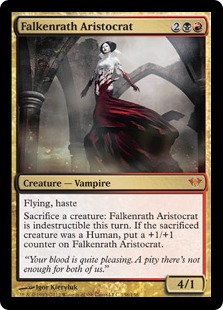 |
vs. |
 |
I give my seal of approval to both versions of The Aristocrats, but only for a player who is willing to stick with it across multiple tournaments and learn it inside and out. If I was just looking for a new deck to pick up and try, I would avoid it.
U/W/R
Creatures (13)
Planeswalkers (2)
Lands (24)
Spells (21)
- 1 Dissipate
- 2 Syncopate
- 3 Pillar of Flame
- 3 Searing Spear
- 1 Mizzium Mortars
- 4 Azorius Charm
- 1 Detention Sphere
- 2 Sphinx's Revelation
- 2 Turn
- 2 Warleader's Helix
Sideboard

If I had to use one deck to represent this Standard format, it would be U/W/R. Over and over again in writing today, I’ve found myself saying things like "there’s more than one way to build this deck" and "I’ve seen people who switch this card for this card." Standard is truly a format without hard and fast rules. U/W/R is the epitome of this concept, as there are dozens—perhaps a hundred—different cards that can be considered in numbers ranging from one to four. You can make the deck as aggressive or defensive as you like, focused to varying degrees on powerful threats or instant speed tricks.
Alex Blackard’s deck represents the aggressive extreme, packing the full four Geist of Saint Trafts alongside Ral Zarek and Thundermaw Hellkite for extra aggression.
Equally competitive is the controlling version of the deck, packing an extra copy of Sphinx’s Revelation, more removal, and sometimes Think Twice or Augur of Bolas.
Last week I wrote that I would never play a slow deck in Standard without having four copies of Thragtusk, and I do stand by that statement. While players like Alex Blackard, Gerry Thompson, Dave Shiels, and Matt Costa have continuously proven that U/W/R is a competitive deck in the hands of a skilled pilot, I just find it to be an underpowered strategy. It runs on thin margins and doesn’t have a real nut draw. Every game will be a struggle, and a long tournament with the deck is an exhausting prospect. Unless you’ve been playing U/W/R for a while already, I recommending picking up one of the aggro decks listed above or one of the slower Thragtusk decks that will follow below.
Jund Midrange
Creatures (13)
Planeswalkers (3)
Lands (25)
Spells (19)

I feel that Jund is a more resilient cousin of U/W/R. Where you lose the trickery of blue’s instants, you gain resilient creatures, life gain, and the potential for great draws with Farseek into powerful threats.
I’ve written extensively on Jund Midrange in the past, and my love for the deck is well known. I feel that it plays the best cards in the format and is remarkably strong against opposing creature decks while having no clear weaknesses. If you’re at a loss for what to play in your next Standard tournament and none of the decks I’ve mentioned have jumped out at you, give Jund Midrange a try.
Junk Reanimator
Creatures (25)
- 3 Acidic Slime
- 3 Arbor Elf
- 2 Fiend Hunter
- 4 Avacyn's Pilgrim
- 4 Restoration Angel
- 3 Thragtusk
- 3 Angel of Serenity
- 1 Deathrite Shaman
- 2 Sin Collector
Lands (23)
Spells (12)

Like Jund, Junk Reanimator features many of the format’s best mid- and late-game creatures, which are meant to either be cast or put into play from the graveyard via Unburial Rites. Junk Reanimator was Standard’s top deck for some time and if anything has only become a better choice now that it’s no longer the uncontested most popular strategy.
I very much like where Andres Martinez has gone with his build, cutting Lingering Souls and Craterhoof Behemoth—which I never felt was a particularly good game plan for this format—in favor of more value creatures like Sin Collector and Acidic Slime. In fact, I like his list so much that I’m willing to let him slide for cutting a Thragtusk. Between us, let’s just swap that third Acidic Slime for a fourth Thragtusk and forget it ever happened…
Esper Control
Creatures (5)
Planeswalkers (4)
Lands (26)
Spells (25)
- 2 Dissipate
- 2 Oblivion Ring
- 2 Forbidden Alchemy
- 4 Lingering Souls
- 4 Azorius Charm
- 4 Supreme Verdict
- 2 Sphinx's Revelation
- 2 Far
- 3 Warped Physique
Sideboard

With such a wide variety of powerful aggressive and midrange decks, the odds are stacked against control in Standard.
The traditional strength of Esper Control was that all it had to do was survive in order to win the game. It could sit around, make land drops, cast giant Sphinx’s Revelations, and inevitably win with Nephalia Drownyard. The growing popularity of Aetherling and Sire of Insanity (especially in combination with Cavern of Souls) among other things makes that strategy unreliable.
Note that Andy Sipka has wisely taken a different approach: being more proactive with his planeswalkers and Lingering Souls. Nonetheless, my complaints against U/W/R also stand against Esper, and I would recommend against picking up a deck like this for an upcoming tournament.
Bant Control
Creatures (8)
Lands (26)
Spells (26)

If there’s hope for control rising to the top of the format again, I believe it lies with Bant. Bant Control is best in a direct Aetherling battle because it has an advantage in mana (because of Farseek) and in life (because of Thragtusk).
The combination of Thragtusk and Supreme Verdict gives Bant a level of defensive capability that neither the Supreme Verdict decks nor the Thragtusk decks can reach on their own.
I’ll be the first to admit that Bant has not yet proven itself in the way that the decks above have, so I recommend against it for a tournament that’s important to you. Nevertheless, I feel that it might be an up and coming strategy that’s worth paying attention to.
Like every other deck in Standard, there are countless ways to construct a Bant deck, and I’ve seen players have success with more aggressive, creature-based builds as well.
It’s a deckbuilder’s world in today’s Standard, and there’s no need to feel restricted by the exact decklists offered in this article. Hopefully, though, this will serve as a helpful jumping-off point for anyone trying to make their mark on the format before M14 shakes things up.

